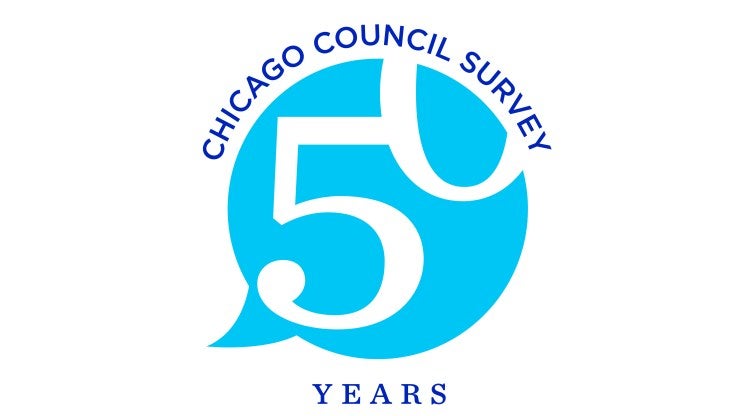While majorities of Democrats and Independents support a path to citizenship for immigrants living and working in the United States illegally, only four in 10 Republicans agree.
In June of this year, President Donald Trump deployed National Guard troops to Democratic stronghold Los Angeles, ostensibly to support Immigration and Customs Enforcement (ICE) in the wake of protests following immigration raids across California. Recent data from the 2025 Chicago Council Survey, fielded July 18-30, 2025, point to a shift in public sentiment, perhaps in part in reaction to these events. Since last year, Americans have tempered their views on immigration as a threat and show record levels of support for legal immigration in the first year of Trump’s second term.
The new data suggest the national conversation around immigration is evolving and may continue to do so given subsequent deployments of the National Guard to Washington, DC, and Chicago. Partisan divides remain sharp, particularly on the treatment of undocumented workers, and, more fundamentally, on the inherent value of racial and ethnic diversity. This brief examines how public opinion has changed over the past year, where consensus is emerging, and where deep divisions persist.
Key Findings
- Record or near-record numbers of Americans support increasing (28%) or maintaining current levels (49%) of legal immigration, while opposition to legal immigration is at an all-time low (21%).
- Just 36 percent of Americans see large numbers of immigrants and refugees arriving in the country as a critical threat, down from 50 percent last year.
- Two-thirds of Americans (65%) say immigrants currently working in the United States illegally should be able to apply for US citizenship, either immediately (43%) or after a penalty and waiting period (22%).
- Only a minority overall favor forcing undocumented workers to leave their jobs and the country altogether (23%), relatively unchanged from last year’s figure (20%).
Support for Legal Immigration Hits All-Time High
Support for legal immigration has hit an all-time high since the Chicago Council Survey first asked this question in 2002. Today, half of Americans (49%) say that legal immigration into the United States should be kept at its present level, up from 44 percent in 2024. That percentage includes similar proportions across partisan groups, with half of Republicans (52%) and nearly as many Independents (48%) and Democrats (47%) in support of maintaining the present level of legal immigration.
Correspondingly, support for decreasing legal immigration has dropped from one-third of Americans (33%) last year to just one-fifth today (21%). This reverses a four-year upward trend from a previous record low of 27 percent in 2020. The timing suggests that Biden-era policies, perceived by many to be ineffectual on a surge of illegal migration on the southwest border, also affected perceptions of migration through legal routes. Under the second Trump administration, attitudes have reversed.
Crucially, all partisan groups have softened their opposition to legal immigration in the space of a year. Overall, just one in three Republicans (34%) want to see lower legal immigration levels today, compared to half last year (50%), aligning with a similar drop revealed in separate polling by Gallup over the summer. Already the most pro-immigration partisan group, Democrats’ desire to curb legal immigration has fallen by half (11%, down from 22%). Independents’ desire to decrease legal immigration has similarly fallen (20%, down from 31%).
Conversely, Democrats have become even more likely to favor increased legal immigration (40%, up from 30% last year), as have Independents (29%, up from 23%). Growing approval among Democrats and Independents has driven the steady uptick in support for higher levels of legal immigration over the past decade. Republican support for these policies has been flat over the same period. Today, just 13 percent favor more legal immigration to the United States.
Softening Stances on Immigration as Critical Threat Since Last Year
The 2025 Chicago Council Survey reveals a general softening of views toward immigrants among the American public. Last year, Chicago Council Survey data noted that half (50%) of Americans viewed “large numbers of immigrants and refugees coming into the United States” as a critical threat to the country’s vital interests. That figure has fallen to slightly more than one-third overall this year (36%).
Like the subsiding opposition to legal immigration, the shift on immigration as a threat affects all partisan groups. In 2024, 83 percent of Republicans believed immigrants and refugees to be a critical threat, the highest figure since the Council began asking this question in 1998. Though they still believe it to be threatening—and it remains a top threat for Republicans—that figure has dropped to a smaller majority of two-thirds this year (68%).
Moderating views come as public concerns shift away from immigration issues to government corruption. Close to a quarter of Americans (73%) believe corruption is a critical threat, making it the top-ranked threat to US interests overall this year, with “weaking democracy in the United States” coming in a close second (65%). Immigration, in contrast, now places second to last as a critical threat, only ahead of the persistent lack of a peace agreement between Israel and the Palestinians (33%) (see Appendix 2).
For some Americans, declining concern over migrants and refugees entering the United States may stem from the perception that the government is currently addressing the issue of immigration. Arrests made by ICE have soared since February, and July's Big Beautiful Bill” expanded the budget for immigration enforcement in an unprecedented way. But as a September New York Times/Siena College poll shows, half of registered voters (51%) believe Trump’s actions on immigration enforcement have gone too far. Already in July, Trump’s approval rating on immigration had fallen to a low of 41 percent, down from 48 percent in January, according to Reuters/Ipsos polling. A July 10-14 AP/NORC poll registered a similar drop, suggesting rising discontent with the administration’s heavy-handed tactics.
Parting Ways: Partisan Views Diverge on Potential Policies to Address Unauthorized Immigration
The primary target of ICE raids and the broadly increased immigration deportation efforts has been the community of 14 million undocumented immigrants living in the United States. How to handle this population has been a point of political contention for decades. Today, a combined majority of Americans (65%) support providing “illegal immigrants who are currently working in the United States” with a pathway to American citizenship.1 More than four in 10 permit citizenship applications to be lodged without further conditions (43%), while a smaller share favors first enforcing a penalty and a waiting period (22%). On the other side of the ledger, one in three Americans (34%) do not support providing immigrants with a path to citizenship at all: 11 percent would allow them to keep their jobs under work permits, while close to a quarter (23%) think they should be required to quit their jobs and leave the United States entirely.
As is the case for many other immigration items, Republicans and Democrats are split on how the United States should handle the large number of undocumented immigrants already within US borders. Democrats broadly favor a path to citizenship for these immigrants, either immediately (65%) or after a penalty and waiting period (20%); two-thirds of Independents agree (42% immediately, 24% with penalty). Republicans are more divided. A plurality and record high (46%) say these immigrants should be forced to leave their jobs and the country, while slightly fewer (43% combined) favor a path to citizenship (21% immediately, 22% with penalty) (see appendix table 2).
Differing assessments of how undocumented workers affect the American job market may partially explain why partisans differ so greatly on how to deal with the undocumented population. While the 2024 Chicago Council Survey found Republicans (48%) and Democrats (87%) to be deeply divided on whether “illegal immigrants mostly take jobs nobody wants,” a 2024 Pew survey shows that three-quarters of American adults (75%) believe undocumented immigrants mostly fill jobs that US citizens do not want, including poorer-paid roles in agriculture, construction, and cleaning services. Recognition of their role in the US economy may be a key factor shaping public views on policy toward undocumented workers.
Equally important, however, is how partisans are responding to Trump’s immigration policy. A CBS/YouGov poll fielded July 16-18, 2025, shows half of Americans overall (51%) now disapprove of Trump’s program to deport undocumented immigrants in the United States, up from just 41 percent in February. That number conceals stark divides. Republican disapproval sits at just one in 10 (9%), compared to six in 10 Independents (59%) and almost nine in 10 Democrats (86%).
These divisions on immigration policy are not new but have deepened over the past decade as Republican and Democratic attitudes have gone in different directions. Today, Republican support for deportations (46%) is the highest level ever recorded in the past decade of Council polling on this issue. This is also the largest gap between Republicans and Democrats on record (at 42 percentage points). But Democrats’ opinions over the past decade have changed even more dramatically. Today, two-thirds (65%) favor allowing unauthorized immigrants to immediately apply for citizenship, up from just 48 percent a decade ago. Independents have also grown more supportive of a path to citizenship, though at a slower pace than Democrats. (See Appendix 2).
Divergence in Preferences for Diversity Persists
A split in fundamental attitudes about America’s racial makeup may very well be driving views on immigration policy options. Republicans and Democrats are deeply split on the inherent benefits of racial and ethnic diversity. Greater than half of Democrats say that welcoming more people of many different races, nationalities, and ethnic groups makes the country a much better place to live (54%). Including an additional 16 percent who think it makes the United States a little better, fully three in four Democrats (73%) think diversity is a good thing. Half of Independents (52%) also believe that diversity makes the country better.
By contrast, just 28 percent of Republicans believe diversity makes the United States a better place to live (12% a lot better, 16% a little better). One in three (34%) are indifferent. And another third (35%) thinks an “increasing number of people of many different races, nationalities, and ethnic groups in the United States” is negative on balance—including one in 10 who say it makes the country a lot worse (13%).
The 44-point gap that separates Republican and Democratic favorability toward racial diversity reflects deep divisions in ideas on what America should look like. Since January, the Trump administration has taken near-indiscriminate aim at minority groups in the United States, examples of which include wide-ranging action against policies supporting Diversity, Equity, and Inclusion and a high-profile deportation of a Salvadorian man in violation of a 2019 court order.
Conclusion
In the past year, American attitudes toward immigration have measurably changed. Concerns about migrants as a critical threat have diminished, while favorable opinion toward maintaining or increasing legal immigration has reached historic highs. These shifts indicate that the broader public is more supportive of inclusive immigration policies than just a year ago.
At the same time, differences between Republicans and Democrats, especially on pathways to citizenship for undocumented workers already in the United States, underscore the continued challenges for policymakers seeking reform. The public largely recognizes the economic importance of America’s undocumented workforce, a potentially key factor shaping public views on policy toward this group.
Despite these shifts, the current administration’s zeal for clamping down on immigration, whether legal or illegal, skilled or unskilled, shows no sign of abating. The architects of Trump’s immigration policy have explicitly espoused a homogenous vision of America and hardline views of how to realize their goals. In this context, persistent divides in public opinion about the inherent benefits of diversity suggest that disagreements about immigration may be about what “America” is, fundamentally, and what it should become.
- 1
To compare recent results to those spanning several decades, the survey uses the language “illegal immigrants” in several questions. In past work, we tested describing undocumented immigrants as “illegal” versus “unauthorized” and found that changing the wording affects respondents’ attitudes on immigration policy. We kept the original wording for 1,077 of 2,148 respondents this year to track changes since the first time we asked the question in 1998. For the remaining 1,071 respondents, we used the adjective “unauthorized.” We observed no statistically significant differences. Detailed results are in the Appendix. Throughout the report, the adjectives “illegal,” “undocumented,” and “unauthorized” are used interchangeably.
Appendix Table 1: Effect of Wording Splits
When it comes to immigration, which comes closest to your view about illegal immigrants who are currently working in the US? (N = 1,077)
| Overall | Republican | Democrat | Independent | R-D Gap | |
|---|---|---|---|---|---|
| They should be allowed to stay in their jobs and to apply for US citizenship | 43 | 21 | 65 | 42 | -44 |
| They should be allowed to stay in their jobs and to eventually apply for US citizenship only if they pay a penalty and wait a number of years | 22 | 22 | 20 | 24 | 2 |
| They should be allowed to stay in their jobs with work permits, but not apply for US citizenship | 11 | 10 | 10 | 12 | 0 |
| They should be required to leave their jobs and leave the US | 23 | 46 | 4 | 21 | 42 |
When it comes to immigration, which comes closest to your view about unauthorized immigrants who are currently working in the US? (N = 1,071)
| Overall | Republican | Democrat | Independent | R-D Gap | |
|---|---|---|---|---|---|
| They should be allowed to stay in their jobs and to apply for US citizenship | 40 | 18 | 65 | 35 | -47 |
| They should be allowed to stay in their jobs and to eventually apply for US citizenship only if they pay a penalty and wait a number of years | 22 | 21 | 19 | 25 | 2 |
| They should be allowed to stay in their jobs with work permits, but not apply for US citizenship | 12 | 13 | 8 | 15 | 5 |
| They should be required to leave their jobs and leave the US | 24 | 46 | 7 | 24 | 39 |
Appendix Table 2: Views on Immigration Policy
When it comes to immigration, which comes closest to your view about illegal immigrants who are currently working in the US?
| Overall | Republican | Democrat | Independent | R-D Gap | |
|---|---|---|---|---|---|
| 2015 | 32 | 17 | 48 | 29 | -31 |
| 2016 | 32 | 20 | 44 | 29 | -24 |
| 2017 | 38 | 24 | 51 | 37 | -27 |
| 2020 | 45 | 26 | 60 | 46 | -34 |
| 2021 | 41 | 26 | 54 | 42 | -28 |
| 2023 | 40 | 22 | 59 | 38 | -37 |
| 2024 | 38 | 21 | 57 | 35 | -36 |
| 2025 | 43 | 21 | 65 | 42 | -44 |
| Overall | Republican | Democrat | Independent | R-D Gap | |
|---|---|---|---|---|---|
| 2015 | 24 | 21 | 29 | 23 | -8 |
| 2016 | 26 | 23 | 27 | 26 | -4 |
| 2017 | 26 | 26 | 26 | 27 | 0 |
| 2020 | 23 | 26 | 23 | 21 | 3 |
| 2021 | 24 | 23 | 25 | 23 | -2 |
| 2023 | 24 | 20 | 24 | 28 | -4 |
| 2024 | 24 | 20 | 25 | 25 | -5 |
| 2025 | 22 | 22 | 20 | 24 | 2 |
| Overall | Republican | Democrat | Independent | R-D Gap | |
|---|---|---|---|---|---|
| 2015 | 13 | 16 | 8 | 16 | 8 |
| 2016 | 13 | 13 | 13 | 13 | 0 |
| 2017 | 11 | 10 | 11 | 12 | -1 |
| 2020 | 12 | 14 | 10 | 12 | 4 |
| 2021 | 12 | 14 | 11 | 12 | 3 |
| 2023 | 13 | 17 | 10 | 14 | 7 |
| 2024 | 12 | 15 | 8 | 13 | 7 |
| 2025 | 11 | 10 | 10 | 12 | 0 |
| Overall | Republican | Democrat | Independent | R-D Gap | |
|---|---|---|---|---|---|
| 2015 | 29 | 45 | 14 | 30 | 31 |
| 2016 | 28 | 42 | 14 | 31 | 28 |
| 2017 | 22 | 37 | 11 | 22 | 26 |
| 2020 | 18 | 34 | 5 | 19 | 29 |
| 2021 | 22 | 36 | 10 | 21 | 21 |
| 2023 | 21 | 41 | 6 | 19 | 35 |
| 2024 | 20 | 44 | 8 | 25 | 36 |
| 2025 | 23 | 46 | 4 | 21 | 42 |
Summary – 2025 data only
| Overall | Republican | Democrat | Independent | R-D Gap | |
|---|---|---|---|---|---|
| They should be allowed to stay in their jobs and to apply for US citizenship | 43 | 21 | 65 | 42 | -44 |
| They should be allowed to stay in their jobs and to eventually apply for US citizenship only if they pay a penalty and wait a number of years | 22 | 22 | 20 | 24 | 2 |
| They should be allowed to stay in their jobs with work permits, but not apply for US citizenship | 11 | 10 | 10 | 12 | 0 |
| They should be required to leave their jobs and leave the US | 23 | 46 | 4 | 21 | 42 |
Appendix Figures 3-5
This analysis is primarily based on data from the 2025 Chicago Council Survey of the American public on foreign policy, a project of the Lester Crown Center on US Foreign Policy.
The 2025 Chicago Council Survey was conducted July 18–30, 2025, by Ipsos using its large-scale, nationwide, online research panel (KnowledgePanel) in English and Spanish among a weighted national sample of 2,148 adults 18 or older living in all 50 US states and the District of Columbia. The margin of sampling error for the full sample is ±2.2 percentage points, including a design effect of 1.07.
Partisan identification is based on how respondents answered a standard partisan self-identification question: “Generally speaking, do you think of yourself as a Republican, a Democrat, an Independent, or what?”
The 2025 Chicago Council Survey is made possible by the generous support of the Crown family and the Korea Foundation.
Additional results reported from August 2025 are from a Chicago Council on Global Affairs-Ipsos survey conducted August 22–24, 2025, by Ipsos using its large-scale, nationwide, online research panel (KnowledgePanel) among a weighted national sample of 1,021 adults 18 or older living in all 50 US states and the District of Columbia. The margin of sampling error for the full sample is ±3.1 percentage points, including a design effect of 1.05.
The data for the total sample were weighted to adjust for gender by age, race/ethnicity, education, Census region, metropolitan status, and household income using demographic benchmarks from the 2024 March Supplement of the Current Population Survey (CPS). The specific categories used were:
- Gender (Male, Female) by Age (18–29, 30–44, 45-59 and 60+)
- Race/Hispanic Ethnicity (White Non-Hispanic, Black Non-Hispanic, Other Non-Hispanic, Hispanic, 2+ Races Non-Hispanic)
- Education (Less than High School, High School, Some College, Bachelor or Higher)
- Census Region (Northeast, Midwest, South, West)
- Metropolitan Status (Metro, Non-Metro)
- Household Income (Under $25,000, $25,000-$49,999, $50,000-$74,999, $75,000-$99,999, $100,000-$149,999, $150,000+)






Related Content
 US Foreign Policy
US Foreign Policy
Results and analysis of the Council's annual survey of American views on foreign policy.
 Defense and Security
Defense and Security
Republican Party supporters stand out as the only partisans in favor of using the military for domestic law enforcement, to suppress protests, and to control immigration.
 Public Opinion
Public Opinion
Republican views of immigrants and immigration policy largely diverge from overall American attitudes.
